Advertisements
Online Mock Tests
Chapters
▶ 1: Force
2: Work, Energy and Power
3: Machines
LIGHT
4: Refraction of Light at Plane Surfaces
5: Refraction through a Lens
6: Spectrum
SOUND
7: Sound
ELECTRICITY AND MAGNETISM
8: Current Electricity
9: Household Circuits
10: Electro-Magnetism
HEAT
11: Calorimetry
MODERN PHYSICS
12: Radioactivity
![Selina solutions for Physics [English] Class 10 ICSE chapter 1 - Force Selina solutions for Physics [English] Class 10 ICSE chapter 1 - Force - Shaalaa.com](/images/physics-english-class-10-icse_6:4c973dd038c545c9a2b6db170ad2f542.jpg)
Advertisements
Solutions for Chapter 1: Force
Below listed, you can find solutions for Chapter 1 of CISCE Selina for Physics [English] Class 10 ICSE.
Selina solutions for Physics [English] Class 10 ICSE 1 Force EXERCISE - 1 (A) [Pages 9 - 12]
State the condition when on applying a force, the body has the translational motion.
State the condition when on applying a force, the body has the rotational motion.
Define the moment of force.
State the S.I. unit of moment of force.
State whether the moment of force is a scalar or vector quantity?
State two factors affecting the turning effect of a force.
When does a body rotate? State one way to change the direction of rotation of a body. Given a suitable example to explain your answer.
Write the expression for the moment of force about a given axis.
What do you understand by the clockwise and anticlockwise moment of force? When is it taken positive?
State one way to reduce the moment of given force about a given axis of rotation.
State one way to obtain greater moment of a given force about a given axis of rotation.
Why is it easier to open a door by applying the force at the free end of it?
The stone of hand flour grinder is provided with a handle near its rim. Give reason.
It is easier to turn the steering wheel of a large diameter than that of a small diameter. Given reason.
A spanner (or wrench) has a long handle. Why?
A jack screw is provided with a long arm. Explain why?
A, B and C are the three forces each of magnitude 4 N acting in the plane of the paper as shown in Figure. The point O lies in the same plane.

- Which force has the least moment about O? Give a reason.
- Which force has the greatest moment about O? Give a reason.
- Name the forces producing
(a) Clockwise
(b) anticlockwise moments. - What is the resultant torque about the point O?
The adjacent diagram shows a heavy roller, with its axle at O, which is to be raised on a pavement XY. If there is friction between the roller and pavement, show by an arrow on the diagram the point of application and the direction of force to be applied. If pivoted at O, now will it go up?

A body is acted upon by two forces of magnitude F but in opposite directions. State the effect of the force if both forces act at the same point of the body.
A body is acted upon by two forces of magnitude F, but in opposite directions. State the effect of the force if the two forces act at two different points of the body at a separation r.
Draw a neat labelled diagram to show the direction of two forces acting on a body to produce rotation in it. Also, mark the point about which rotation takes place by the letter O.
What do you understand by the term couple?
State the couple's effect on a body.
Give two examples of a couple's actions in our daily life.
Define the moment of a couple.
Write S.I. unit of moment of couple.
Prove that
Moment of couple = Force × couple arm.
What do you mean by an equilibrium of a body?
State the condition when a body is in static equilibrium.
Give one example of static equilibrium.
State the condition when a body is in dynamic equilibrium.
Give one example of dynamic equilibrium.
State two conditions for a body acted upon by several forces to be in equilibrium.
State the principle of moments.
Describe a simple experiment to verify the principle of moments, if you are supplied with a metre rule, a fulcrum and two springs with slotted weights.
Complete the following sentences :
The S.I. unit of moment of force is ______.
In equilibrium algebraic sum of moments of all forces about the point of rotation is ______.
In a beam balance, when the beam is balanced in a horizontal position, it is in ______ equilibrium.
The moon revolving around the earth is in ______ equilibrium.
MULTIPLE CHOICE TYPE
The moment of a force about axis depends ______.
only on the magnitude of force
only on the perpendicular distance of force from the axis
neither on the force nor on the perpendicular distance of force from the axis
on both the force and its perpendicular distance from the axis
A body is acted upon by two unequal forces in opposite directions, but not in the same line. The effect is that ______.
the body will only have rotational motion.
the body will have only the translational motion.
the body will have neither the rotational motion nor the translational motion.
the body will have rotational as well as translational motion.
NUMERICALS
A nut is opened by a wrench of length 25 cm. If the least force required is 10 N, find the moment of force needed to turn the nut.
A wheel of diameter 2 m is shown in the figure with the axle at O. A force F = 2 N is applied at B in the direction shown in the figure. Calculate the moment of force about
- the centre O, and
- the point A.
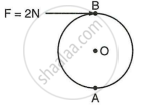
The diagram in Fig shows two forces F1 = 5 N and F2 = 3 N acting at points A and B respectively of a rod pivoted at a point O, such that OA = 2 m and OB = 4 m.

Calculate:
- the moment of force F1 about O.
- the moment of force F2 about O.
- total moment of the two forces about O.
Two forces each of magnitude 10 N act vertically upwards and downwards respectively at the two ends A and B of a uniform rod of length 4 m which is pivoted at its midpoint O as shown in the figure. Determine the magnitude of the resultant moment of forces about the pivot O.
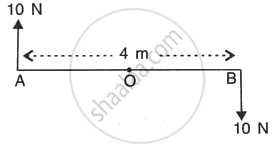
The figure shows two forces each of magnitude 10 N acting at the point A and B at a separation of 50 cm, in opposite directions. Calculate the resultant moment of two forces about the point.
- A,
- B and
- O situated exactly at the middle of the two forces.
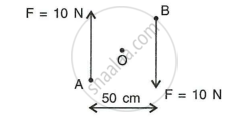
A steering wheel of diameter 0.5 m is rotated anticlockwise by applying two forces each of magnitude 6 N. Draw a diagram to show the application of forces and calculate the moment of forces applied.
A uniform metre rule is pivoted at its mid-point. A weight of 50 gf is suspended at one end of it. Where should a weight of 100 gf be suspended to keep the rule horizontal?
A uniform metre rule balances horizontally on a knife edge placed at the 58 cm mark when a weight of 20 gf is suspended from one end.
- Draw a diagram of the arrangement.
- What is the weight of the rule?
The diagram below shows a uniform bar supported at the middle point O. A weight of 40 gf is placed at a distance of 40 cm to the left of the point O. How can you balance the bar with a weight of 80 gf?

The figure shows a uniform metre rule placed on a fulcrum at its mid-point O and having a weight 40 gf at the 10 cm mark and a weight of 20 gf at the 90 cm mark.
- Is the metre rule in equilibrium? If not how will the rule turn?
- How can the rule be brought in equilibrium by using an additional weight of 40 gf?

When a boy weighing 20 kgf sits at one end of a 4 m long see-saw, it gets depressed at this end. How can it be brought to the horizontal position by a man weighing 40 kgf.
A physical balance has its arms of length 60 cm and 40 cm. What weight kept on pan of the longer arm will balance an object of weight 100 gf kept on other pan?
The diagram in Fig. shows a uniform metre rule weighing 100 gf, pivoted at its centre O. Two weights 150 gf and 250 gf hang from the point A and B respectively of the metre rule such that OA = 40 cm and OB = 20 cm. Calculate :
- the total anticlockwise moment about O,
- the total clockwise moment about O,
- the difference of anticlockwise and clockwise moments, and
- the distance from O where a 100 gf weight should be placed to balance the metre rule.
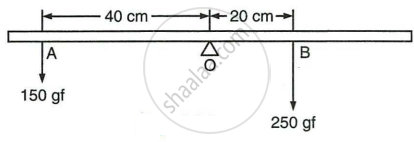
A uniform metre rule of weight 10 gf is pivoted at its 0 mark.
- What moment of force depresses the rule?
- How can it be made horizontal by applying a least force?
A uniform half-metre rule can be balanced at the 29.0 cm mark when a mass of 20 g is hung from its one end.
- Draw a diagram of the arrangement.
- Find the mass of the half-metre rule.
- In which direction would the balancing point shift if 20 g mass is shifted inside from its one end?
A uniform metre rule of mass 100 g is balanced on the fulcrum at mark 40 cm by suspending an unknown mass m at the mark 20 cm.
- Find the value of m.
- To which side the rule will tilt if the mass m is moved to the mark 10 cm?
- What is the resultant moment now?
- How can it be balanced by another mass of 50 g?
In figure, a uniform bar of length l m is supported at its ends and loaded by a weight W kgf at its middle. In equilibrium, find the reactions R1 and R2 at the ends.

`["Hint:" "In equilibrium" "R"_1 + "R"_2 = "W" "and" "R"_1 xx l/2 = "R"_2 xx l/2]`
Selina solutions for Physics [English] Class 10 ICSE 1 Force EXERCISE - 1 (B) [Pages 14 - 15]
Define the term 'centre of gravity of a body'.
State a factor on which the position of the centre of gravity of a body depend? Explain your answer with an example.
What is the position of the centre of gravity of a rectangular lamina?
What is the position of the centre of gravity of a cylinder?
At which point is the centre of gravity situated in a triangular lamina?
At which point is the centre of gravity situated in a circular lamina?
A square cardboard is suspended by passing a pin through a narrow hole at its one corner. Draw a diagram to show its rest position. In the diagram, mark the point of suspension by the letter S and the centre of gravity by the letter G.
Explain how you will determine experimentally the position of the centre of gravity for a triangular lamina (or a triangular piece of cardboard).
State whether the following statements are true or false.
'The position of the centre of gravity of a body remains unchanged even when the body is deformed'.
True
False
'The centre of gravity of a freely suspended body always lies vertically below the point of suspension'.
True
False
A uniform flat circular rim is balanced on a sharp vertical nail by supporting it at point A, as shown in the figure. Mark the position of the centre of gravity of the rim in the diagram by the letter G.
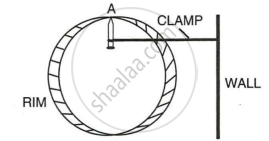
The figure shows three pieces of cardboard of uniform thickness cut into three different shapes. On each diagram draw two lines to indicate the position of the centre of gravity G.

MULTIPLE CHOICE TYPE
The centre of gravity of a uniform ball is ______.
at its geometrical centre
at its bottom
at its topmost point
at any point on its surface
The centre of gravity of a hollow cone of height h is at distance x from its vertex where the value of x is ______.
`h/3`
`h/4`
`(2h)/3`
`(3h)/4`
Selina solutions for Physics [English] Class 10 ICSE 1 Force EXERCISE - 1 (C) [Page 18]
Explain the meaning of uniform circular motion.
Why is uniform circular motion said to be accelerated?
Draw a neat labelled diagram for a particle moving in a circular path with a constant speed. In you diagram show the direction of velocity at any instant.
Is it possible to have an accelerated motion with a constant speed? Name such type of motion.
Give an example of motion in which speed remains uniform, but the velocity changes.
A uniform circular motion is an accelerated motion. Explain it. State whether the acceleration is uniform or variable? Name the force responsible to cause this acceleration. What is the direction of force at any instant? Draw a diagram in support of your answer.
Differentiate between uniform linear motion and uniform circular motion.
Name the force required for circular motion. State its direction.
What is a centripetal force?
Explain the motion of a planet around the sun in an elliptical path.
With reference to the direction of action, how does a centripetal force differ from centrifugal force?
Is centrifugal force considered as the force of reaction of the centripetal force?
Compare the magnitudes of centripetal and centrifugal force.
Is centrifugal force a real force?
| A small pebble tied at one end of a string is placed near the periphery of a circular disc, at the centre of which the other end of the string is tied to a peg. The disc is rotating about an axis passing through its centre. |
- What will be your observation when you are standing outside the disc? Explain.
- What will be your observation when you are standing at the centre of the disc? Explain.
A piece of stone tied at the end of a thread is whirled in a horizontal circle with uniform speed by hand. Answer the following questions:
- Is the velocity of stone uniform or variable?
- Is the acceleration of stone uniform or variable?
- What is the direction of acceleration of stone at any instant?
- Which force provides the centripetal force required for circular motion?
- Name the force and its direction which acts on the hand.
State two differences between the centripetal and centrifugal force.
State whether the following statements are true or false by writing T/F against them.
Earth moves around the sun with uniform velocity.
True
False
The motion of the moon around the earth in a circular path is an accelerated motion.
True
False
A uniform linear motion is unaccelerated, while a uniform circular motion is an accelerated motion.
True
False
In a uniform circular motion, the speed continuously changes because of the direction of motion changes.
True
False
A boy experiences a centrifugal force on his hand when he rotates a piece of stone tied at one end of a string, holding the other end in the hand.
True
False
MULTIPLE CHOICE TYPE
Which of the following quantity remains constant in a uniform circular motion?
Velocity
speed
acceleration
Both velocity and speed
The centrifugal force is ______.
a real force
the force of reaction of centripetal force
a fictitious force
Directed towards the centre of circular path
Solutions for 1: Force
![Selina solutions for Physics [English] Class 10 ICSE chapter 1 - Force Selina solutions for Physics [English] Class 10 ICSE chapter 1 - Force - Shaalaa.com](/images/physics-english-class-10-icse_6:4c973dd038c545c9a2b6db170ad2f542.jpg)
Selina solutions for Physics [English] Class 10 ICSE chapter 1 - Force
Shaalaa.com has the CISCE Mathematics Physics [English] Class 10 ICSE CISCE solutions in a manner that help students grasp basic concepts better and faster. The detailed, step-by-step solutions will help you understand the concepts better and clarify any confusion. Selina solutions for Mathematics Physics [English] Class 10 ICSE CISCE 1 (Force) include all questions with answers and detailed explanations. This will clear students' doubts about questions and improve their application skills while preparing for board exams.
Further, we at Shaalaa.com provide such solutions so students can prepare for written exams. Selina textbook solutions can be a core help for self-study and provide excellent self-help guidance for students.
Concepts covered in Physics [English] Class 10 ICSE chapter 1 Force are Force, Translational and Rotational Motions, Couple, Principle of Moments, Uniform Circular Motion (UCM), Centrifugal Forces, Centripetal Force, Moment (Turning Effect) of a Force Or Torque, Equilibrium of Bodies and Its Types, Centre of Gravity, Force, Translational and Rotational Motions, Couple, Principle of Moments, Uniform Circular Motion (UCM), Centrifugal Forces, Centripetal Force, Moment (Turning Effect) of a Force Or Torque, Equilibrium of Bodies and Its Types, Centre of Gravity.
Using Selina Physics [English] Class 10 ICSE solutions Force exercise by students is an easy way to prepare for the exams, as they involve solutions arranged chapter-wise and also page-wise. The questions involved in Selina Solutions are essential questions that can be asked in the final exam. Maximum CISCE Physics [English] Class 10 ICSE students prefer Selina Textbook Solutions to score more in exams.
Get the free view of Chapter 1, Force Physics [English] Class 10 ICSE additional questions for Mathematics Physics [English] Class 10 ICSE CISCE, and you can use Shaalaa.com to keep it handy for your exam preparation.
